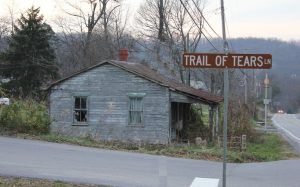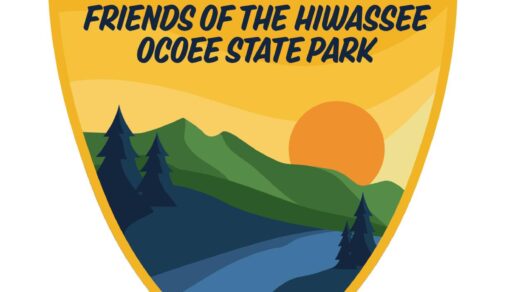 The Old Federal Road: Researched & composed by Allen Parke Swayne & James Parke Swayne
The Old Federal Road: Researched & composed by Allen Parke Swayne & James Parke Swayne
During the westward expansion of the original colonies, both north and south of the Cherokee Nation, there was great need for a mail route to link the expanding settlements. Since the Cherokee Nation occupied the area from the mountains of North Carolina westward to Red Boiling Springs in middle Tennessee, the United States settlements in Georgia could not communicate with anyone living in Virginia. The idea of negotiating with the Cherokee for a mail route from Knoxville to Augusta, Georgia may have started as early as 1792 when George Washington began his second term as president.
The route was obtained in 1806 with the agreement that the U.S. Government would pay the Cherokee $1,600.00 and was known by The Tellico Treaty. The route was laid out by a party of Indians and whites and it ran from Niles Ferry on the Little Tennessee River, southward into Georgia. The area went through the land occupied by the Cherokee Nation and the route took advantage of favorable terrain for travelers.
The actual construction of the Old Federal Road was apparently done by the Indians who also ran the ferries crossing the Hiwassee and Ocoee Rivers. The excellent choice of right-of-way is impressive from an engineering standpoint. From Niles Ferry to Conasauga it does not deviate as much as one-half mile from a straight line. It follows low-shale ridges in most places and it following creeks and swampy areas.
Starting from the very old Niles Ferry Crossing of the Little Tennessee River, near the present U.S. Highway 411 bridge, the road went in an almost straight line to a point about two miles east of the present town of Madisonville. Here in 1828, the newly created Monroe County erected its first courthouse on what is now the Ross Jewell farm. It was a two-story log building with the jail on the top floor.
The road continued southward past the present site of Coltharp School, intersected Tennessee Highway #68 for a short distance and passed the site of Nonaberg Church. East of Englewood, it continued on the east side of McMinn Central High School and crossed Highway #411 near the railroad overpass. Apparently, when the railroad was built, a road just on the east side of the tracks leading into Etowah was called the Old Federal Road. This has caused some confusion as to location but it is well established that the original road came near Old Williamsburg and ran through the Doug Tullock property. By keeping on this route, it missed the low ground and swampy conditions that were typical of the Etowah area and its vicinity.
Keeping on the higher ground along the west side of Etowah, the road continued near Cog Hill and the Hiwassee Riber, near the mouth of Conasauga Creek. It may have passed through the town of Columbus, but it is more likely that the ferry was farther downstream. Columbus was the first county seat of Polk County and at one time it had a hotel, two stores and two churches. The little town faded out of existence after the Ocoee Purchase of 1835, when Benton was chosen for the county seat. The last empty building was used in 1860 by the U.S. Army to build a pontoon bridge across the Hiwassee River so that troops could be moved toward Chattanooga.
Three grave sites remain on the hill overlooking the old town site of Columbus. They are of Col. Henry Bradford, 1776/1871 and his wife Rachel Farland Bradford and Stanwix Hord, son of Col. Hord. These graves sites are easily found in this area, although they were untended for years and were in a deplorable condition until restored and fenced in 1995.
About a mile up Conasauga Creek from its mouth is the site of the Hildebrand Mill. It was built about 1807 by the U.S. Government for the Cherokee Indians. John Hildebrand was of German descent and was manager of the first hotel in Knoxville when he was hired to build a grist mill for the Indians at a mutually satisfactory site. The site on Conasauga Creek was selected and the mill was constructed. Hildebrand married a Cherokee woman and raised his family in Polk County.
From the ferry on the Hiwassee River the road ran through the site of the present Benton courthouse. It followed the site of the Welcome Valley Road for some distance and then crossed the Ocoee River at the Hildebrand Landing. One of the Hildebrands built a fine house on the south side of the Ocoee River. This dwelling still exists although it has been moved a short distance. It was owned by Mr. & Mrs. Willis Trew but has been deeded to the Polk County Historical Society upon the death of the present occupant.
From Hildebrand Landing the road ran south and crossed U.S. Highway #64 at a point where there is now a Church of God. Continuing south near Old Fort, it crossed U.S. Highway #411 and came to the Conasauga River at McNair Landing. The McNairs were part Cherokee and were moved out on the Trail of Tears in 1838. The McNair gravesite was still in existence in 1950.
Since the Hildebrand Landing on the Tennessee-Mississippi Rivers system the Old Federal Road was used as a portage route to cut off over a thousand miles of travel from the water route to Mobile Bay. Heavy carts pulled by oxen moved boats from Hildebrand to McNair. One cargo boat was reported to carry one hundred barrels of flour and whiskey, but the proportion of each was not given. A proposal to build a canal to replace the portage was found to be not feasible.
Near the south end of the village of Tennga, Georgia is an historic marker alongside of Highway #411 which states the Old Federal Road was close to its path for the next twenty-five miles southward.
Besides the developments already mentioned, there were several other historic sites that were built near the Old Federal Road. A few of these are as follows:
- Vastine Stickley House in Madisonville
- Cantrell Grave near Etowah
- Nonaburg Church near Englewood
- Etowah Depot
- Cog Hill Seminary near Etowah
- Trew’ Store near Etowah
- Old Fort blockhouse in Benton
- Carlock Academy near Etowah
- Methodist Campground near Etowah
- Williamsburg near Etowah
- Half Moon Sotre in Monroe County
- Ho Store in Monroe County
- Sequoyah Birthplace museum near Vonore
- Hildebrand landing to McNair Landing, portage route in Polk County
As we have traced the history and route of the Old Federal Road, it has been found to be one of the most important sites which aided in the historical development of the States of Georgia and Eastern Tennessee. Please make some allowances for the hand-drawn path on the map above. It does deviate a small amount from the actual path.
- Coltharp School and Coltharp Community so called after the Coltharp family…many of which still reside in the area.
- Nonaberg Church still active.
- The Hildabrand lineage is well documented by several people…all of altering heritages, African-American, White & Cherokee. For more information please email [email protected] This family had marriages within the Mayfield, Starr & several other families in the area.
- The Church of God spoken of is “Ocoee Church of God”.
- The Old Fort Blockhouse spoken of originally stood approximately 1 mile north of McNairs Ferry. In the mid 1950’s the building was moved from its original location to its current location near the Polk County Jail in Benton, TN.




Most talked about today